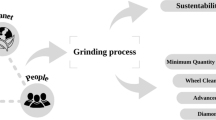Summary
The aim of this study was to evaluate the relationships between the length of time a cutting fluid was used, its content in polycyclic aromatic hydrocarbons (PAHs) and its mutagenic potential. The PAH concentrations were determined by means of a high-resolution gas chromatograph-mass spectrometer in samples of new cutting fluid and in samples used for 3, 6 and 9 months. The following PAHs were measured: phenanthrene, anthracene, fluoranthene, pyrene, benzo[a]anthracene, chrysene + triphenylene, benzo [e] pyrene, benzo [a]-pyrene and perylene. Mutagenicitiy assays were carried out on the aforementioned samples using the Ames test. Salmonella typhimurium TA98 was used as an indicator to show up mutagens capable of inducing frame-shift genetic changes, and Escherichia coli WP2 uvrA was used as an indicator to detect mutagens capable of inducing base pair genetic changes. The mutagenic tests were carried out with and without microsomial activation, using 1:1, 1:10, 1:20 and 1: 50 dilutions of cutting fluid samples. An increase in the concentrations of total PAHs over time was observed in the samples of cutting fluid used for 3, 6 and 9 months. The highest percentage increase in PAH concentrations was observed in the 6-month-old sample (10 times the initial concentration, from 45 to 411.8 μg of oil). None of the samples were mutagenic to S. typhimurium without metabolic activation or to E. coli with and without metabolic activation. All samples except for the 1:1 diluted sample showed moderate but significant mutagenic activity in the S. typhimurium test with metabolic activation. Mutagenicity rose to its highest levels (similar to those observed with the mutagenic compound 2-acetylaminofluorene, which was used as a positive control) in the 9-month-old sample and in the 6-month-old 1:20 and 1:50 diluted sample. This study shows an increase in the PAH concentrations and mutagenicity of cutting fluids following prolonged use. In order to minimize the risk caused by such an increase in PAH content, it is recommended that the cutting fluid be changed at least every 6 months.
Similar content being viewed by others
References
Agarwal R, Gupta KP, Kumar S, Mehrotra NK (1986) Assessment of some tumorigenic risks associated with fresh and used cutting oil. Ind J Exp Biol 24:508–510
Ames BN, McCann J, Yamasaki E (1975) Methods for detecting carcinogens and mutagens with the Salmonella/mammalian microsome mutagenicity test. Mutat Res 31:347
Badger GM (1962) The chemical basis of carcinogenic activity. Thomas, Springfield, Ill.
Bingham E, Horton AW (1969) Environmental carcinogenesis: experimental observations related to occupational cancer. Adv Biol Skin 7:183–193
Catchpole WM, Macmillan E, Powell H (1971) Specification for cutting oils with special reference to carcinogenicity. J Inst Petrol 57:247–260
Cottica D, Bertagna A (1985) Significato di alcuni valori limite per situazioni complesse di inquinamento: idrocarburi aromatici policiclici (IPA). Atti del 6° Congresso Nazionale dell'Associazione degli Igienisti Industriali. Gubbio, pp 157–185
Doak SMA, Hend RW, Van der Wiel A, Hunt PF (1985) Carcinogenic potential of hydrotreated petroleum aromatic extracts. Br J Ind Med 42:380–388
Evans MJ, Hooper WB, Ingram AJ, Pullen DL, Aston RHR (1989) The chemical, physical and biological properties of a neat cutting oil during prolonged use in a large manufacturing facility. Ann Occup Hyg 33:537–553
Eyres AR (1981) Polycyclic aromatic hydrocarbon contents of used metalworking oils. Petrol Rev February: 32–35
Gradiski D, Vinot J, Zissu D, Limasset JC, Lafontaine M (1983) The carcinogenic effect of a series of petroleum derived oils on the skin of mice. Environ Res 32:258–268
Granella M, Clonfero E (1991) The mutagenic activity and polycyclic aromatic hydrocarbon content of mineral oils. Int Arch Occup Environ Health 63:149–153
IARC (1987) Monographs on evaluation of the carcinogenic risk of chemicals to human. Suppl. 7. Lyon
Jarvholm B, Fast K, Lavenius B, Tomsic P (1985) Exposure to cutting oils and its relation to skin tumours and premalignant skin lesions on the hands and forearms. Scand J Work Environ Health 11:365–369
Jarvholm B, Lavenius B (1987) Mortality and cancer morbidity in workers exposed to cutting fluids. Arch Environ Health 42:361–366
Jongeneelen FJ, Anzion RBM, Scheepers PTJ, Bos RP, Henderson PT, Nijenhuis EH, Veenstra SJ, Brouns RME, Winkes A (1988) 1-hydroxypyrene in urine as a biological indicator of exposure to polycyclic aromatic hydrocarbons in several work environments. Ann Occup Hyg 32:35–43
Kira S, Hayatsu H, Nogami Y, Ogata M (1989) Monitoring of mutagenicity in cutting fluids during their recycled use. Ind Health 27:17–21
Milton L, Novotny MV, Bartle KD (1981) Analytical chemistry of polycyclic aromatic compounds. Academic Press, New York
Thony C, Thony J, Lafontaine M, Limasset JC (1975) Occurrence of carcinogenic polycyclic aromatic hydrocarbons in some cutting oils: study of the corresponding risk. Arch Mal Prof 36:37–52
Waterhouse JAH (1971) Cutting oils and cancer. Ann Occup Hyg 14:161–170
Author information
Authors and Affiliations
Rights and permissions
About this article
Cite this article
Apostoli, P., Crippa, M., Fracasso, M.E. et al. Increases in polycyclic aromatic hydrocarbon content and mutagenicity in a cutting fluid as a consequence of its use. Int. Arch Occup Environ Heath 64, 473–477 (1993). https://doi.org/10.1007/BF00381094
Received:
Accepted:
Issue Date:
DOI: https://doi.org/10.1007/BF00381094




